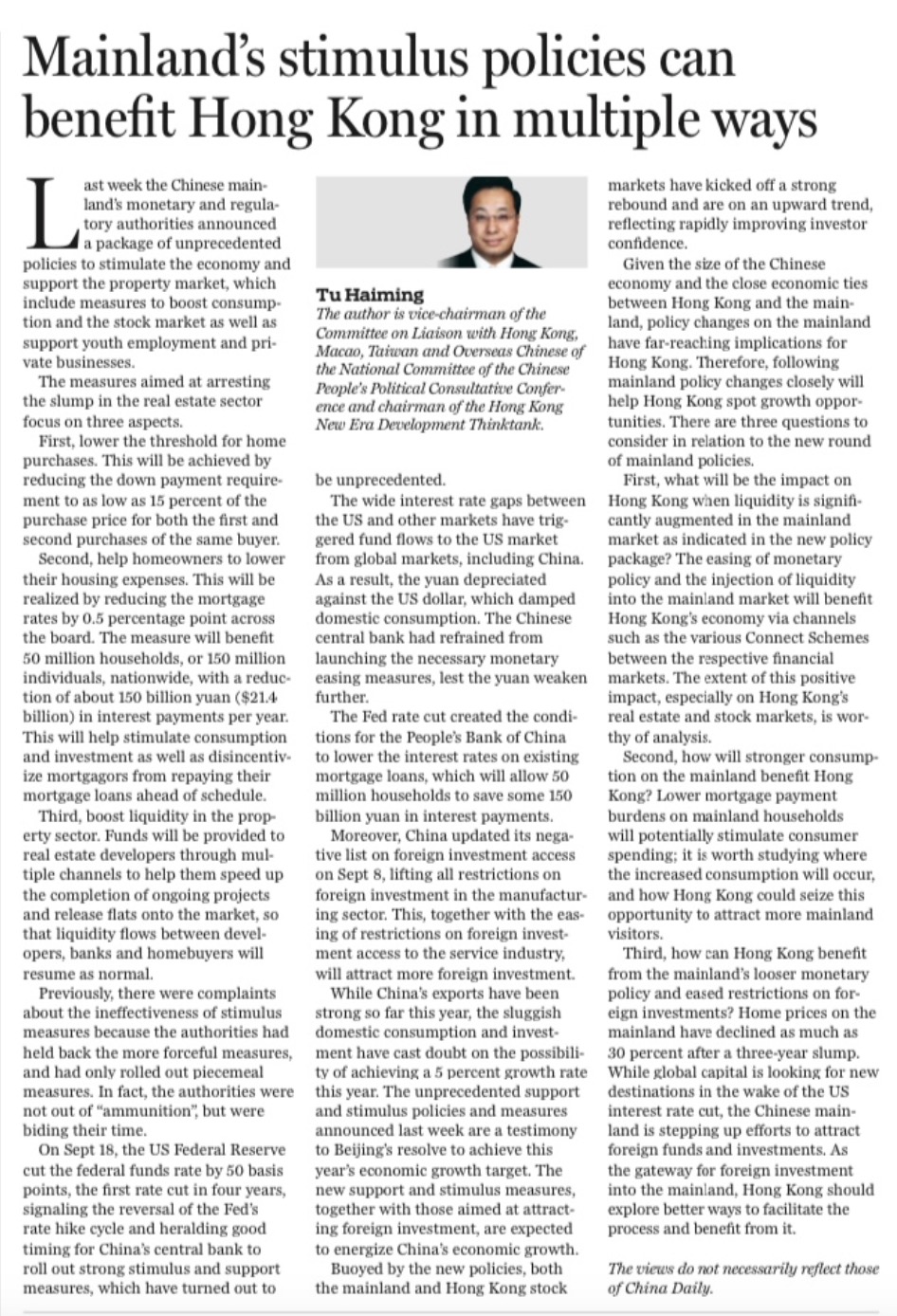Tu Haiming: Mainland’s stimulus policies can benefit Hong Kong in multiple ways ![]()
![]()
Last week the Chinese mainland’s monetary and regulatory authorities announced a package of unprecedented policies to stimulate the economy and support the property market, which include measures to boost consumption and the stock market as well as support youth employment and private businesses.

The measures aimed at arresting the slump in the real estate sector focus on three aspects.
First, lower the threshold for home purchases. This will be achieved by reducing the down payment requirement to as low as 15 percent of the purchase price for both the first and second purchases of the same buyer.
Second, help homeowners to lower their housing expenses. This will be realized by reducing the mortgage rates by 0.5 percentage point across the board. The measure will benefit 50 million households, or 150 million individuals, nationwide, with a reduction of about 150 billion yuan ($21.4 billion) in interest payments per year. This will help stimulate consumption and investment as well as disincentivize mortgagors from repaying their mortgage loans ahead of schedule.
Third, boost liquidity in the property sector. Funds will be provided to real estate developers through multiple channels to help them speed up the completion of ongoing projects and release flats onto the market, so that liquidity flows between developers, banks and homebuyers will resume as normal.
Previously, there were complaints about the ineffectiveness of stimulus measures because the authorities had held back the more forceful measures, and had only rolled out piecemeal measures. In fact, the authorities were not out of “ammunition”, but were biding their time.
On Sept 18, the US Federal Reserve cut the federal funds rate by 50 basis points, the first rate cut in four years, signaling the reversal of the Fed’s rate hike cycle and heralding good timing for China’s central bank to roll out strong stimulus and support measures, which have turned out to be unprecedented.
The wide interest rate gaps between the US and other markets have triggered fund flows to the US market from global markets, including China. As a result, the yuan depreciated against the US dollar, which damped domestic consumption. The Chinese central bank had refrained from launching the necessary monetary easing measures, lest the yuan weaken further.
The Fed rate cut created the conditions for the People’s Bank of China to lower the interest rates on existing mortgage loans, which will allow 50 million households to save some 150 billion yuan in interest payments.
Moreover, China updated its negative list on foreign investment access on Sept 8, lifting all restrictions on foreign investment in the manufacturing sector. This, together with the easing of restrictions on foreign investment access to the service industry, will attract more foreign investment.
Global capital is looking for new destinations in the wake of the US interest rate cut, the Chinese mainland is stepping up efforts to attract foreign funds and investments. As the gateway for foreign investment into the mainland, Hong Kong should explore better ways to facilitate the process and benefit from it
While China’s exports have been strong so far this year, the sluggish domestic consumption and investment have cast doubt on the possibility of achieving a 5 percent growth rate this year. The unprecedented support and stimulus policies and measures announced last week are a testimony to Beijing’s resolve to achieve this year’s economic growth target. The new support and stimulus measures, together with those aimed at attracting foreign investment, are expected to energize China’s economic growth.
Buoyed by the new policies, both the mainland and Hong Kong stock markets have kicked off a strong rebound and are on an upward trend, reflecting rapidly improving investor confidence.
Given the size of the Chinese economy and the close economic ties between Hong Kong and the mainland, policy changes on the mainland have far-reaching implications for Hong Kong. Therefore, following mainland policy changes closely will help Hong Kong spot growth opportunities. There are three questions to consider in relation to the new round of mainland policies.
First, what will be the impact on Hong Kong when liquidity is significantly augmented in the mainland market as indicated in the new policy package? The easing of monetary policy and the injection of liquidity into the mainland market will benefit Hong Kong’s economy via channels such as the various Connect Schemes between the respective financial markets. The extent of this positive impact, especially on Hong Kong’s real estate and stock markets, is worthy of analysis.
Second, how will stronger consumption on the mainland benefit Hong Kong? Lower mortgage payment burdens on mainland households will potentially stimulate consumer spending; it is worth studying where the increased consumption will occur, and how Hong Kong could seize this opportunity to attract more mainland visitors.
Third, how can Hong Kong benefit from the mainland’s looser monetary policy and eased restrictions on foreign investments? Home prices on the mainland have declined as much as 30 percent after a three-year slump. While global capital is looking for new destinations in the wake of the US interest rate cut, the Chinese mainland is stepping up efforts to attract foreign funds and investments. As the gateway for foreign investment into the mainland, Hong Kong should explore better ways to facilitate the process and benefit from it.
(The author is vice-chairman of the Committee on Liaison with Hong Kong, Macao, Taiwan and Overseas Chinese of the National Committee of the Chinese People’s Political Consultative Conference and chairman of the Hong Kong New Era Development Thinktank.)
(From China Daily)
https://res.youuu.com/zjres/2024/10/7/U6PzNv8S8a5IRax5F8Op73wrj1xEoa9A431.jpg











掃描二維碼分享到手機














